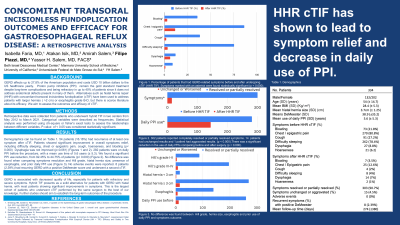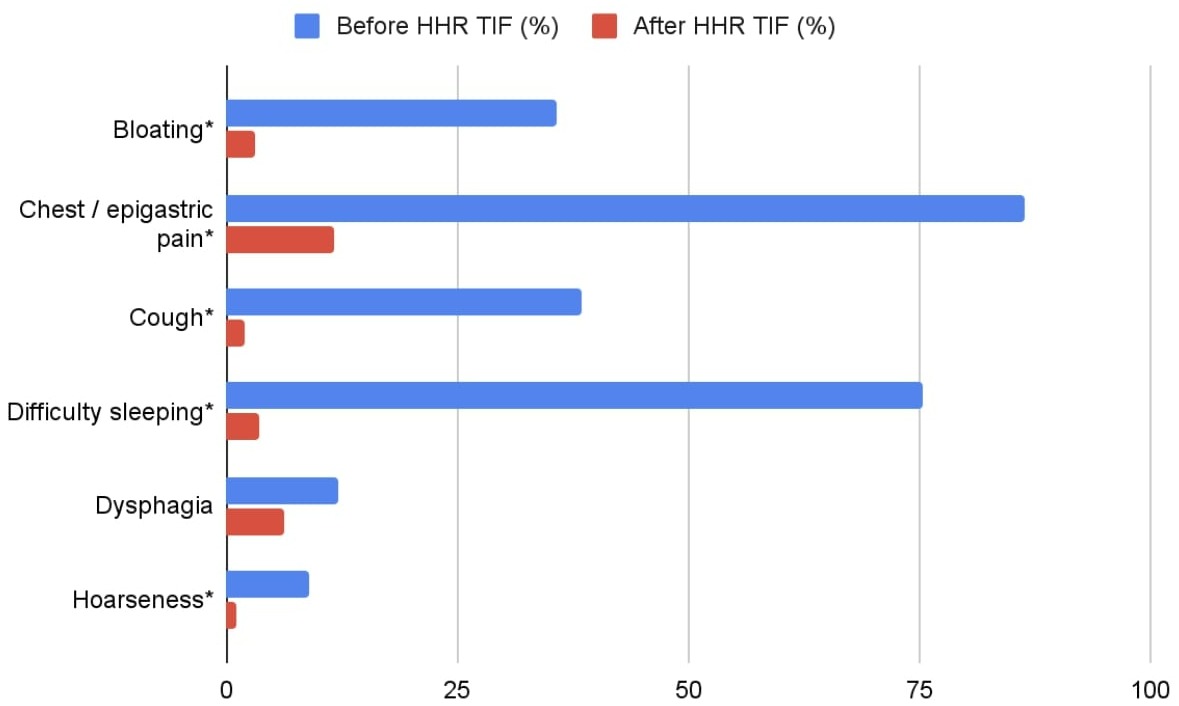Back


Poster Session D - Tuesday Morning
Category: Interventional Endoscopy
D0443 - Concomitant Transoral Incisionless Fundoplication Outcomes and Efficacy for Gastroesophageal Reflux Disease: A Retrospective Analysis
Tuesday, October 25, 2022
10:00 AM – 12:00 PM ET
Location: Crown Ballroom

Has Audio
- FP
Filipe Piazzi, MD
Universidade Federal do Mato Grosso do Sul
UNION, NJ
Presenting Author(s)
Award: Presidential Poster Award
Isabella Faria, MD1, Atakan Isik, MD2, Amirah Salem, 3, Filipe Piazzi, MD4, Yasser H. Salem, MD5
1Universidade Federal de Minas Gerais, Boston, Minas Gerais, Brazil; 2Marmara University School of Medicine, Los Angeles, CA; 3University of California, Irvine, Irvine, CA; 4Universidade Federal do Mato Grosso do Sul, Union City, NJ; 5OC Surgical, Orange County, CA
Introduction: Gastroesophageal reflux disease (GERD) affects up to 27.8% of the American population and costs USD 10 billion to the US healthcare yearly. Proton pump inhibitors (PPIs) remain the gold standard treatment despite long-term complications and being refractory in up to 40% of patients since it does not address the anatomical defects that might be present. Alternatives such as hiatal hernia repair with concomitant transoral incisionless fundoplication (cTIF) have been used to manage patients with larger hernias ( >2 cm) or esophagitis grade B-D, but there is scarce literature about its efficacy. Therefore, we aim to assess the outcomes and efficacy of cTIF.
Methods: Retrospective data were collected from patients who underwent hybrid TIF in two centers from May 2012 to March 2021. Categorical variables were described as frequencies. Statistical analysis was performed using chi-square or fisher’s exact tests to assess the relationships between different variables. Results with a p-value < 0.05 were considered statistically significant.
Results: Of 334 patients, 133 were male (39.82%) and 201 female (60.18%). Mean age was 54 (± 14.7). Mean BMI was 28.4 (± 5.3), mean size of hiatal hernia was 3.7cm (± 1.25) and mean DeMeester score was 38.9 (±35.2). 52 patients (16.35%) had recurrence of at least one symptom after cTIF. Patients showed significant improvement in difficulty sleeping, chest or epigastric pain, cough, hoarseness, and bloating (p< 0.000). Dysphagia was not improved (p=0.061). 282 patients were on daily proton pump inhibitors (PPI) before the procedure, with a mean use time of 5.6 years (± 5.3). We found a significant PPI use reduction, from 92.45% to 44.75% of patients (p< 0.000). No adverse events were reported. 8 patients (2.39%) had recurring GERD with a positive DeMeester score and underwent a second cTIF.
Discussion: GERD is associated with decreased quality of life, especially for patients with refractory and severe symptoms. Hybrid TIF presents as a solid alternative for patients with GERD with hiatal hernia, with most patients showing significant improvements in symptoms. This is the largest cohort of patients who underwent cTIF performed by the same surgeon to the best of our knowledge. Further studies should aim to establish the long-term outcomes of the procedure.

Disclosures:
Isabella Faria, MD1, Atakan Isik, MD2, Amirah Salem, 3, Filipe Piazzi, MD4, Yasser H. Salem, MD5. D0443 - Concomitant Transoral Incisionless Fundoplication Outcomes and Efficacy for Gastroesophageal Reflux Disease: A Retrospective Analysis, ACG 2022 Annual Scientific Meeting Abstracts. Charlotte, NC: American College of Gastroenterology.
Isabella Faria, MD1, Atakan Isik, MD2, Amirah Salem, 3, Filipe Piazzi, MD4, Yasser H. Salem, MD5
1Universidade Federal de Minas Gerais, Boston, Minas Gerais, Brazil; 2Marmara University School of Medicine, Los Angeles, CA; 3University of California, Irvine, Irvine, CA; 4Universidade Federal do Mato Grosso do Sul, Union City, NJ; 5OC Surgical, Orange County, CA
Introduction: Gastroesophageal reflux disease (GERD) affects up to 27.8% of the American population and costs USD 10 billion to the US healthcare yearly. Proton pump inhibitors (PPIs) remain the gold standard treatment despite long-term complications and being refractory in up to 40% of patients since it does not address the anatomical defects that might be present. Alternatives such as hiatal hernia repair with concomitant transoral incisionless fundoplication (cTIF) have been used to manage patients with larger hernias ( >2 cm) or esophagitis grade B-D, but there is scarce literature about its efficacy. Therefore, we aim to assess the outcomes and efficacy of cTIF.
Methods: Retrospective data were collected from patients who underwent hybrid TIF in two centers from May 2012 to March 2021. Categorical variables were described as frequencies. Statistical analysis was performed using chi-square or fisher’s exact tests to assess the relationships between different variables. Results with a p-value < 0.05 were considered statistically significant.
Results: Of 334 patients, 133 were male (39.82%) and 201 female (60.18%). Mean age was 54 (± 14.7). Mean BMI was 28.4 (± 5.3), mean size of hiatal hernia was 3.7cm (± 1.25) and mean DeMeester score was 38.9 (±35.2). 52 patients (16.35%) had recurrence of at least one symptom after cTIF. Patients showed significant improvement in difficulty sleeping, chest or epigastric pain, cough, hoarseness, and bloating (p< 0.000). Dysphagia was not improved (p=0.061). 282 patients were on daily proton pump inhibitors (PPI) before the procedure, with a mean use time of 5.6 years (± 5.3). We found a significant PPI use reduction, from 92.45% to 44.75% of patients (p< 0.000). No adverse events were reported. 8 patients (2.39%) had recurring GERD with a positive DeMeester score and underwent a second cTIF.
Discussion: GERD is associated with decreased quality of life, especially for patients with refractory and severe symptoms. Hybrid TIF presents as a solid alternative for patients with GERD with hiatal hernia, with most patients showing significant improvements in symptoms. This is the largest cohort of patients who underwent cTIF performed by the same surgeon to the best of our knowledge. Further studies should aim to establish the long-term outcomes of the procedure.

Figure: Figure 1. Percentage of patients that had GERD-related symptoms before and after undergoing cTIF (HHR TIF). The most common symptoms before the procedure were chest or epigastric pain, difficulty sleeping, and cough. Almost half of the patients with positive dysphagia symptoms had symptom relief (p=0.061). Symptoms marked with an asterisk were found statistically significant (p < 0.000).
Disclosures:
Isabella Faria indicated no relevant financial relationships.
Atakan Isik indicated no relevant financial relationships.
Amirah Salem indicated no relevant financial relationships.
Filipe Piazzi indicated no relevant financial relationships.
Yasser Salem indicated no relevant financial relationships.
Isabella Faria, MD1, Atakan Isik, MD2, Amirah Salem, 3, Filipe Piazzi, MD4, Yasser H. Salem, MD5. D0443 - Concomitant Transoral Incisionless Fundoplication Outcomes and Efficacy for Gastroesophageal Reflux Disease: A Retrospective Analysis, ACG 2022 Annual Scientific Meeting Abstracts. Charlotte, NC: American College of Gastroenterology.

